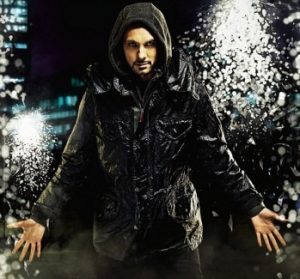Having spent such a long time working in various ways on ‘television for women’, I realised lately that there are actually relatively few programmes watched together in my heterosexual, two-toddler household. Quality dramas that require investment tend to stack up on the Sky+ recorder and I might watch half of them alone. Outside of some motorsport and Masterchef, we haven’t watched a lot of television together since the sad passing of ER. That was until a friend pointed us to Dynamo: Magician Impossible on Watch. I can’t say I was convinced when I first heard about it, I have no interest in magic or magic tricks and I actively dislike some of the usual fare of male magicians, especially those that think they can read your mind. But I want to suggest that there is something compelling about Dynamo for the way in which it presents the personalities of Dynamo/ Steven Frayne through its documentary style that means that there is something in it for both of us.
Watch is one of a portfolio of channels which form UKTV, owned 50% by BBC Worldwide, and launched as a general entertainment channel supported by programming from the BBC archive. It has now become UKTV’s flagship channel. The first of two series of Dynamo was launched on watch in 2011, and the third is currently being filmed. It became the Channel’s most watched programme with 1.7 million viewers and was nominated for the 2012 National Television Awards for best entertainment programme. The programme was felt to be a ‘word of mouth’ success and Dynamo now has something like 1.5 million twitter followers and a fan following of ‘Dynamites’.
Steven Frayne AKA Dynamo is a street magician and according to the Watch website, in the first series: ‘the 28-year-old travels the globe as the unassuming anti-hero who just happens to astound everyone he meets, whether international footballer, Hollywood actor or passer-by on the street.’ The opening credits are dark and mysterious – shot like a US crime drama following a hooded figure as he walks down the urban street, establishing Dynamo’s air of mystique.

Fig 1: Dynamo and Hood
His tricks range from epic grand stunts like the newsworthy walking across the Thames, making himself disappear and walking down the side of buildings, to card tricks in the street, linking together polo mints, or putting someone’s ring inside a bottle. The range of magic is really impressive (no rabbits out of hats of course) which is most often performed out on the street to ‘ordinary’ passers-by as well as celebrities. As viewers we are convinced by the reactions of the people when they are left astounded and bewildered as we watch them react, sometimes in slow motion. There is no real ‘ta dah’ where Dynamo takes in the adulation, he simply and coolly walks away. The magic is clever and entertaining and despite the celebrities and the scale of the magic tricks, the whole series taken together is really rather earnest.
What is most interesting to me is not so much the magic, although I am often amazed, but the way the tricks are embedded into a documentary format with some undertones of a social message. The success of the programme is partly related to how well Dynamo’s back-story works for ‘first-person’ documentary. He opens by saying, ‘let me take you on a journey into my world’ and we experience the magic alongside a relatively slow-reveal of his private life. The media reports around him focus upon his working-class background and a narrative of social mobility. He is the son of a single mum, an 8 stone weakling who learnt magic from his grandfather in order to stop bullies putting him in a wheelie bin on a council estate in Bradford. Newspaper headlines run like this, ‘Wimp who walks on water: bullied at school for being puny he’s the council house boy who’s become our most mesmerising magician’. His personal story is carefully woven around the magic, even his Crohn’s disease and x-rays make an appearance. One episode where he mixes with the stars is intercut with images of him driving home following signposts to Bradford. Rather than ending the show with a trick, or a stunned face, it rather simply closes with him getting out of the car at a block of flats on a council estate, pressing the buzzer, and asking for his nan. The dramatic and the extraordinary are exaggerated by the realism of the ordinary and very unassuming Steven Frayne. We have the mysterious celebrity magician hero Dynamo and the working class anti-hero Steven. So used are we to media personae that it doesn’t really jar, rather it’s the key to its success.
Frayne’s career took off as a magician to the stars and so he refers to popstars like ‘Jay Z’ and Damon Albarn as old friends. He never appears star-struck: he performs the same kind of trickery over celebrities as he does to the man or woman in the street. The series seamlessly moves between the worlds of celebrity glamour and the street, held together by the reiterated narrative of each stunning magic trick. But as a documentary it also looks really good. When he goes to Brazil or America, the series uses some of the qualities of a travel documentary with stunning vistas and landscapes. Colourful images of carnival or the Nevada desert meet the ethnographic trail of Dynamo as he enters the ‘real’ world ‘of the people’ and reflects on what he sees. In Brazil, much of the time is spent in the favelas where he performs tricks playing football with children barefoot, pulling coins out of their hands.

Fig 2: Frayne with children
He describes wanting to go to Brazil to reconnect with his magic after suffering from a period of depression after his grandfather died which is edited with family photographs. There he apparently fin
ds new inspiration with the voice over, ‘I guess this is why I came into magic in the first place. To bring people together, to make a connection’. Stephen Frayne’s voice is in some ways the ‘Voice of God’ of traditional documentary but it is not an authoritative voice; it is the slightly shaky voice of a young lad from Bradford.
The picture that is building is one replete with religious overtones. We witness a very uncomfortable lunch with a Brazilian friend and his mother in a favela where Dynamo uses ‘magic to overcome the language barrier’. The awkward dinner is overlaid with choral music as the magic begins to works on two levels. Frayne walks about as man of the people (he is always walking or driving), performing Jesus-like miracles, turning Coke into Fanta, walking on water, and the end of the Brazilian episode even sees him levitating in front of Christ the Redeemer in Rio to the shock and awe of the tourists.

Fig 3: Walking on Water
I actually like the melodrama of it all, and this emphasis upon ‘all people’ means there’s a little room for social conscience. In his visit to LA he describes Venice Beach as ‘more like a melting point for lost souls, the beach has become a refuge for drifters, drunks and homeless people, casualties of the American Dream’ and he performs tricks with these people too, respectfully and quietly with a refreshing absence of judgement.
So, whilst my partner is replaying the magic tricks asking ‘how did he do that?’ and we discuss the various possibilities, I am enjoying the melodrama, the myriad of ordinary people and the story of Stephen Frayne. There’s plenty to discuss there too. Interestingly in 2010 Watch re-launched its brand identity under new straplines: ‘TV is better shared’ and ‘watch together’. In an environment where individual viewing has become much more prominent, I like the merits of television as an ultimately social phenomenon, I just never expected it to come from a programme about magic.
Helen Wood is Professor of Media and Communication at De Montfort University in Leicester. She has published Talking With Television (2009) University of Illinois Press, with Beverley Skeggs, Reality Television and Class (2011) BFI Palgrave and Reacting to Reality Television (2012) Routledge. She is editor of the European Journal of Cultural Studies and is currently working on the AHRC project ‘A History of Television for Women’.



